The
Sultan and his brother early 1900s

The Sultan Mohamed Imaduddine VI Iskander (left) and his brother
the Prince Maandoogey Dorhy Manippulu with a courtier. They are
wearing black alpaca shirts and the black lungikolhu
wraparounds worn by senior members of the Royal House of Huraagey
and Hilaaly, when they are not in ceremonial regalia. Both were
the site editor's father's uncles.
The
Sultan and his brother aborad a foreign warship late circa late
1890s

The Sultan Mohamed Imaduddine VI Iskander (seated middle right)
and his brother the Prince Maandoogey Tuttu Manippulu (the site
editor's paternal grandfather) aboard a foreign warship. Somehow
the crew do not look British. They may be French.
The
Sultan's Missive ceremony Colombo 1920s

The Sultan's Ambassador Athireegay Abdul Hameed Didi poses with
the Governor of Ceylon Brigadier-General Sir William Henry Manning,
GCMG, KBE, CB and men of the Ceylon "Native Regiment"
(sic.). On the Governor's left is Kakaagey Hussain Hilmy Didi.
In July 2008, we received a note from Christopher
Buyers, an old contact on Ceylon historical issues as follows:
"You seem to variously describe groups of uniformed Ceylonese
as members of the "Ceylon Native Regiment", "Colombo
militia", etc. However, this is not correct. Those with the
long many-buttoned frock coat, swords and sashes, often seen with
dark sun hats or "topees", are high ranking noblemen.
They were mostly drawn from the ranks of the heads of the low-country
Sinhalese and Tamil nobility, though one or two were appointed
"for merit". They held a variety of titles such as Maha
Mudaliyar, Padikara Mudaliar, Raja Vasal Mudaliyar, Udagaha Mudaliyar,
Mudaliyar of Siyane Korale East, Gate Mudaliyar, etc. I am not
sure of the exact hierarchy but the Maha Mudaliyar was highest
in rank, followed by the Padikara Mudaliyar. After the Mudaliyars
came two other ranks of Mohottiyar and Muhandiram.
"Those gentlemen in bare feet with frock coats and white
sarongs, usually also holding spears and wearing pointed hats,
were members of the Governor's Bodyguard. They were also recruited
from some sort of "traditional element", but were not
actually military personnel. If one ever saw them one parade,
a more unmilitary and undisciplined band would be hard to find.
Even when marching they simply walked, usually out of step and
looking from side to side at whatever interested them in the crowd,
surrounding buildings or topography."
We are grateful for Mr. Buyers for this information and acknowledge
that the use of the term "Ceylon Native Regiment" is
not correct in this context.
The
Sultan's Missive ceremony Colombo 1940s

The Sultan's Ambassador Eggamugey Ibrahim Ali Didi poses with
the men of the Ceylon Native Regiment (sic.- see
note), the missive bearer and the Maldive Government Trade
Agent (far left) in Ceylon
Maldive
students at Royal College Colombo 1920s
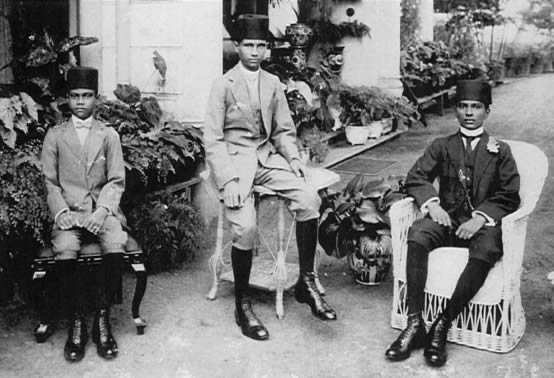
The Sultan Mohamed Shamsuddine III Iskander's son (far right)
and nephews in Colombo attending Royal College. From left, Prince
Hassan Farid Didi, Prince (later sultan) Mohamed Farid Didi and
the Prince Henveyru Ganduvaru Manippulu.
The
Sultan offering prayers at the Central Shrine circa 1933
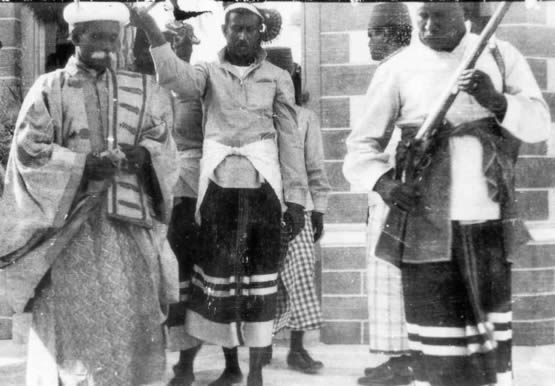
The Sultan Mohamed Shamsuddine III Iskander makes a right turn
on Meduziyaaraiy Magu at the Central Shine from which the street
derives its name. He has just finished offering prayers to a saint
buried in the shrine. Before the advent of real Islam in the Maldives
in 1979, praying to saints in shrines dotted across the archipelago
was common and was more popular than offering prayers to Allah
in mosques. White penance flags surrounded these shrines. The
Saudi and Egyptian trained mullahs banned these flags in 1979.
All but very few important of these shrines were demolished following
orders from Medina.
Court
ladies over the ramparts of the Etherekoilu circa 1930s
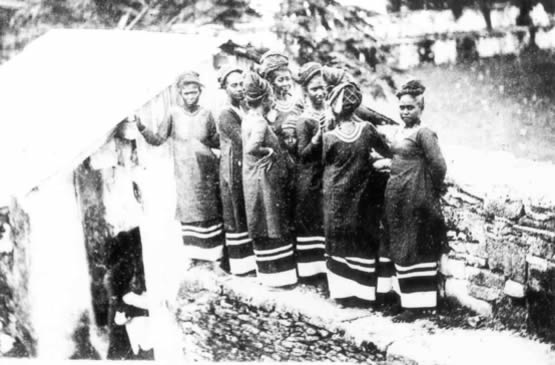
Female court officials atop the ramparts of the Etherekoilu- residence
of the Sultan. They are wearing their distinctive dark red turbans
known as bolufeyli.
Chief
mullahs in their clerical robes during the final days of the absolute
monarchy 1930s
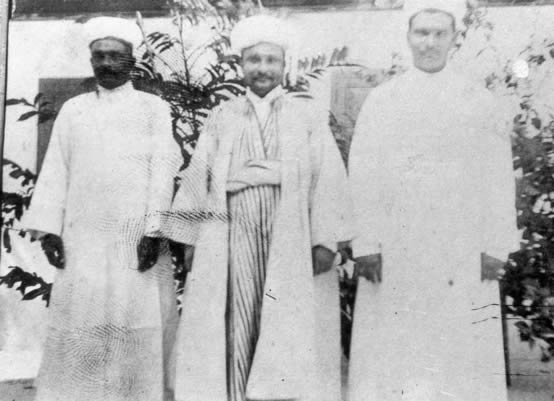
Under the absolute monarchy that existed in the Maldives from
antiquity until 1932, the Maha Sangha (pre 1153) , the
Church (in the 1550s to 1570s), the Mosque and the state were
strictly separated. In Islamic times the mullahs had jurisdiction
only over the mosques and certain civil and moral trials. Civil
life was free from their control and therefore Islam had a limited
role. Under constitutional rule the demarcation between mosque
and state became progressively blurred. Now the mosque has control
over almost all aspects of civil life.
Royal
Navy warship 1930s
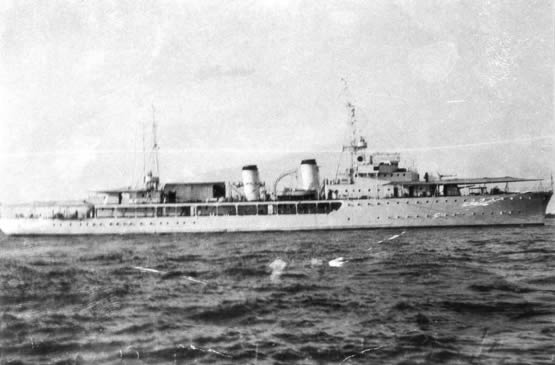
A Royal Navy warship in Malé harbour in the early 1930s.
Under the Agreement between the Sultan and His Majesty's Government,
the Royal Navy was charged with the defence of the islands. The
only visible sign of this arrangement was the occasional visit
of a Royal Navy ship to the islands.
Royal
Navy ratings early 1930s
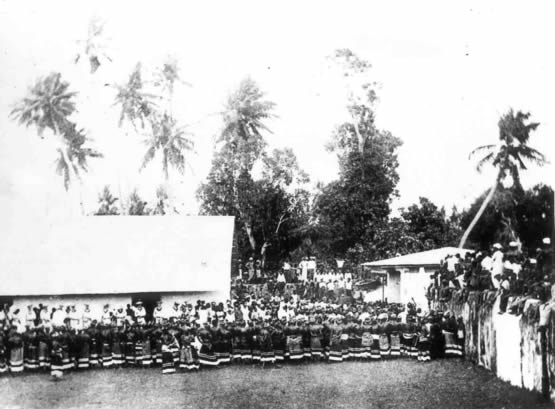
Royal Navy ratings and men of the Royal militia assembled in Malé
with members of the public looking on.
Royal
Navy officers early 1930s
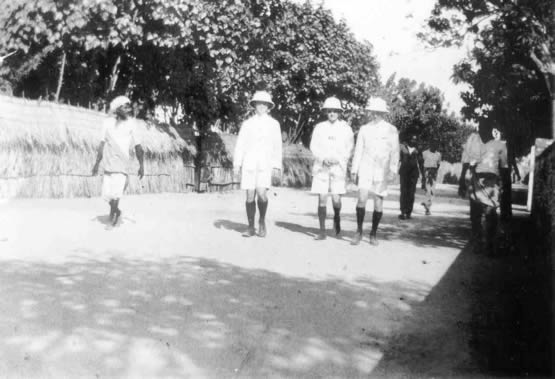
Royal Navy officers taking a stroll along a Malé back street
with members of the public walking along with them.
Royal
Navy officer with the Sultan's nephew and son early 1930s
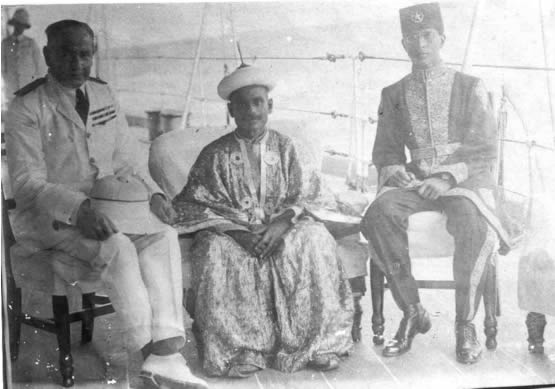
A Royal Navy officer entertains the Sultan's nephew (probaby the
Prince Macchangoli Ganduvaru Manippulu) and the Sultan's son the
Prince Henveyru Ganduvaru Manippulu (far right).
Visiting
colonial officers being entertained by one of the Royal martial
arts corps in the 1930s
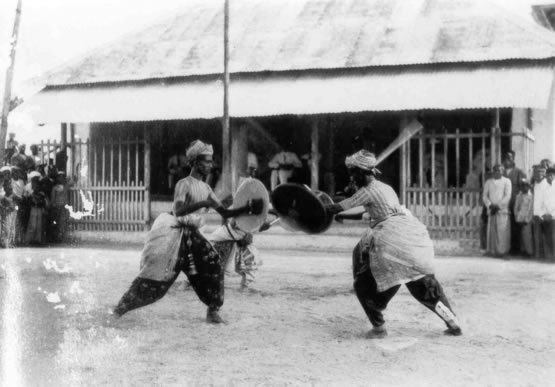
The ceremonial martial arts routines here depicting a form of
fencing called kulhijehun. The British found this rather
quaint and wrote memos about how boring these shows were.
Borahs
circa 1930s
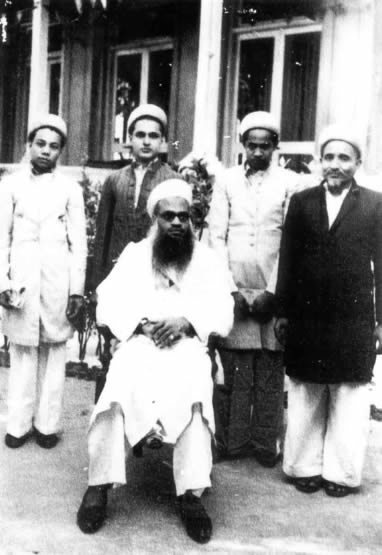
The Bohrah community were not subjects of the Sultan
but had right of residence as traders. Most of them were Ismaili
Shia Muslims. Here leading members of the Ismaili community are
pictured with their mullah. Other businessmen in Malé of
the time who were not subjects of the Sultan included Indian Parsis,
Indian Bahais, Ceylon Moors and a small community from Kathmandu.
A
leading Borah in the 1950s
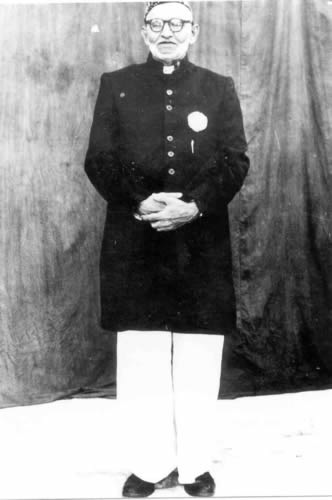
Nagariya Hassan Kaleyfanu, a leading member of the
Borah community. Kaleyfanu left the Maldives in the early 1960s
but returned for a visit in 1967. The last members of the Borah
community in the Maldives were F. Mohamedali and Taherali Gholamhossein.
The latter lived until the 1980s.
Royal
Militia on parade circa 1932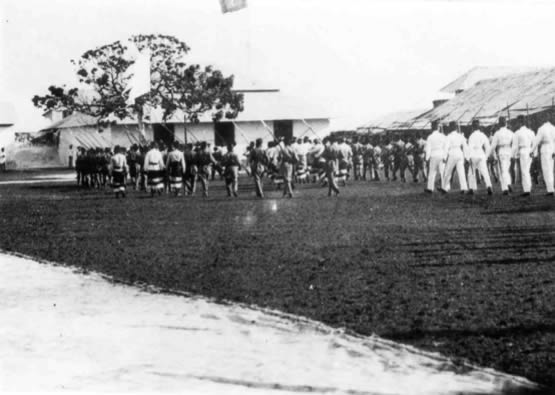
Troops and band of the royal militia regiments parade in the plaza
outside the main precincts of the Etherekoilu, now occupied by
the main mosque of Malé. At the rear in white uniforms
is the naval or Kalasin Regiment. At the front left is
the Hangun or Lancers' Regiment and on their right are
the royal bandsmen. On the far right are the Sifain or
Infantry Regiment.
Victims
of a failed experiment in democracy 1933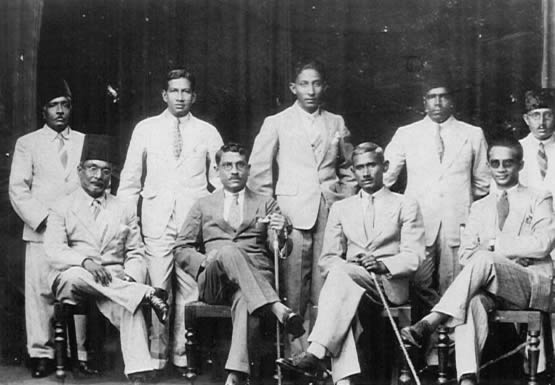
Democracy in the form of the first written constitution was incepted
in the Maldives in 1932. Soon the democratically elected government
found itself at a loss as to what democracy was. They failed to
consider the political maturity of Maldivians and proceeded to
enact reforms. Some of the reforms voted in included building
a railway line from Maafannu to Macchangoli, a distance of less
than a kilometre. Trees were planted along the middle of the main
street in Malé to resemble a French boulevard. Soon the
citizenry found themselves alienated and cried out for a return
to the bad old days of absolute monarchy. A coup took place with
a junta of sixty eight leading citizens replacing the government.
The junta was led by the wealthiest local businessman in Malé
at the time, a certain Gulhee Isa Kaleyfan. They petitioned the
Sultan to suspend the constitution and take absolute control.
The Sultan Mohamed Shamsuddine III Iskander did as he was bid
and ordered his most unpopular ministers into exile in Colombo.
Some of the ex-ministers are photographed here in Colombo. From
left (seated) Hussain Salahuddine, Henveyrugey Ahmed Kamil Didi;
Eggamugey Ibrahim Ali Didi; Athireegey Mohamed Amin Didi (not
an exile). Back row from left: Medu Seedeege Seedi (he was not
a minister but a busy body who was foolish enough to advise the
Sultan to order the militia to open fire on the assembled citizenry
who were demanding an end to democracy); Meerubahuru Mohamed Ismail
Didi, Hilihilaagey Moosa Didi; Kelaa Ibrahim and Buruneegey Ibrahim Hassan Didi.
Council
of Regency offer prayers circa 1933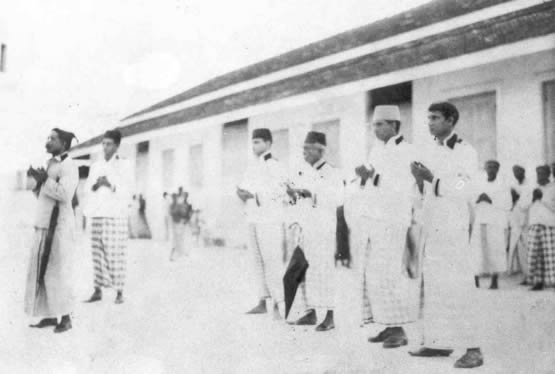
Sultan Mohamed Shamsuddine III Iskander was deposed in 1933 after
a return to constitutional rule. In the interregnum a Council
of Regency took constitutional powers of the Sultan. Here the
Council of Regency is led in prayer at the Central Shrine of Medu
Ziyaaraiy by the Chief Justice Bodufenvalhugey Seedi. The
latter was the site editor's maternal grandfather.
Uploaded 16 January 2008





















